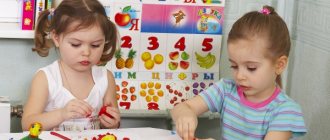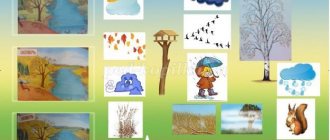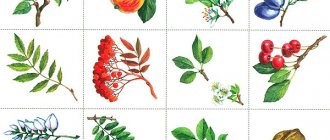Abstract of work in nature
Subject:
Organization of work in nature for children “Care for indoor plants.”
Software tasks:
Training tasks:
- to help consolidate children’s knowledge about indoor plants of the group: their names, distinctive features of appearance and methods of caring for them using symbols;
Developmental tasks:
- to promote the development of the ability to care for plants, using a labor process model for this: set a goal (to help the plant so that it feels good again); choose an object of labor (a plant with drooping leaves, the ground is dry, gray, select tools and material; perform labor actions in the correct sequence (hold the watering can with both hands, place the spout on the edge of the pot, pour over the entire ground, little by little, wait until the water is absorbed and will appear on the pallet); get the result (a watered plant that will soon feel good);
Educational tasks
:
- promote the development of a desire to take care of indoor plants, an understanding of the need to help a living being;
-contribute to the development of accuracy and work culture
Type of labor
: labor in nature
Form of organization:
order
Type of work:
joint
Equipment:
aprons for each child, tools: rags for each child, a basin with water, watering cans with water, sticks for loosening the soil, oilcloths, a sprayer.
Preliminary work:
Observation of a plant (familiarity with the features of appearance, structure, observation of plants in favorable and unfavorable conditions (lack of moisture, a series of experiments to identify the moisture needs of plants, observation of the work of a teacher in watering plants in a corner of nature (familiarity with the model of the labor process).
Teacher training:
drawing up notes, reading methodological literature, selecting equipment, memorizing sayings about work.
Vocabulary work:
A) enrichment:
loosening, wiping, tray, watering, settled water, lump of earth, fix the name color.
B) activation:
plants, flower, earth
Progress of the lesson:
The game character Carlson arrives sad (he flew into an open window while ventilating during nap time). Says hello to every child.
Educator.
Our Carlson is somehow sad. Let's ask him what happened.
Carlson.
I flew past the garden and saw such beautiful and well-groomed flowers on the windowsills outside the windows. Living with me on the roof is my only flower, which my friend Malysh gave me, but something happened to him, he probably got sick.
My favorite plant was as beautiful as in the picture (model shows)
and now it’s like this (shows the plant)
I don’t know what happened to it, I feel sorry for the plant, that’s why I’m crying.
Educator.
Children, do you feel sorry for the plant? Let's take pity on him, tell him kind words: good, don't cry, we will help you, you will become beautiful and healthy again.
Educator
. Why did Carlson's plant become like this? What do plants need to feel good? Listen to what the plant is asking for. Carlson, your plant needs to be looked after and it will get better.
Carlson.
But I don’t know how to care for plants, and now my plant will probably die.
Educator.
Can we help Carlson? How? (We can teach him how to care for plants.) Shall we teach Carlson how to properly care for plants? (We will;)
Educator.
How do we want the plant to feel? (Okay.) So that it becomes what? (With the children they say: so that the plant feels good, so that the leaves look up, so that the stem looks up, so that the ground is moist.) In order not to forget about this, we will put a picture (the model is a plant in good condition)
Educator
. What plant is it now? (The plant is being examined: the condition of the leaves, stem, soil.) In order not to forget what kind of plant it is now, we will put a picture (the model plant is in an unfavorable condition)
The plant needs help as soon as possible. What else do we need for this? To do this, you need to choose the right tools, or assistant objects.
Carlson
. I know what's needed. (Brings an empty watering can. The empty watering can is examined and why it cannot be used for watering is discussed.)
Educator.
Which watering can should you take? Water is filled into the watering can in advance so that the water settles and is at room temperature. What other helper items do we need to help our plants? Children name the remaining objects. In order not to forget what we need, we will put a picture (model - tools: watering can with water, oilcloth, basin with water, rags, stick for loosening the soil, sprayer)
Now what are we going to do?
Children:
And now we will take care of the plants.
Educator:
That's right, but first, we must consider the plants we have chosen for care and determine what our plants love and what kind of care each one needs. And the cards that are glued to each pot of a houseplant will help us with this. (Plants are examined, the name of the plant, distinctive features of appearance are recalled, methods of caring for them are determined using symbols.)
Carlson:
Well, now can you start caring for the plants?
Educator:
Yes, but only for this, we need to remember where we start, because caring for a plant is not only watering it.
Children:
First we take care of the leaves, we wipe the leaves, spray them, then we wipe the pots, then we wash the trays, after that we loosen the soil in the pots and only lastly we water the plants. (If children find it difficult to determine the sequence of methods for caring for plants or have forgotten something, draw the children’s attention to the operation cards)
Educator:
Well done, guys, you clearly remembered all the steps to care for plants, now you can get to work, but first everyone needs to put on their aprons and roll up their sleeves. Now we will distribute who will do what work, I will help you. (After distributing responsibilities, the children go to the table with tools and choose a helper object) And you, Carlson, look carefully and remember what the guys are doing.
Children perform tasks under the supervision of a teacher, the execution of actions goes as far as watering.
Carlson.
I remembered how to water, can I show you? (Holds the watering can with one hand, pours water on the leaves, under the roots, wants to pour all the water out of the watering can at once.)
Educator.
Why can't you water the leaves? Why do you need to water the soil? (Children explain and show how to water correctly.)
Educator.
How much water will we pour?
Carlson
. Until it's all over! (Children explain to hold the watering can with both hands, place the spout on the edge of the pot, pour it all over the ground, little by little, wait until the water is absorbed and appears on the tray. Children, focusing on the model of the labor process, independently water the plants
Carlson, together with the teacher, observes the children’s work, asks clarifying questions. In case of difficulties, the teacher comes to the children’s aid. At the end of the lesson, the teacher and the game character check how the children watered the plants.)
Educator.
What will the plant become if we have cared for it properly? (Children explain.) In order not to forget, we will put a picture (model - a plant in good condition).
Educator.
Carlson, we helped your plant, taught you how to care for indoor plants, now it will get better. We showed you on some plants in our group how to care for plants, what conditions are required for different plants and what care is needed to make them look like in the picture. (Shows a model - the plant is in good condition.) Educator. Soon our plants will become as beautiful and healthy as in the picture. (Shows the model a plant in a favorable condition.) They will feel good. Today we did two good deeds: we helped the plants (listen to what they tell you) and taught Carlson how to care for his plant.
Carlson.
Thank you guys, now my plant will always feel good. I'm very happy about this.
Educator.
Guys, are you glad that you helped the plants? (Emotionally share the joy of the children.) Let's give Carlson this flower in memory of us - Clivia, so that his flower will have more fun, so that he is not alone. And you, Carlson, don’t forget to take care of your plants and come visit us again! Goodbye!
Follow-up work
Continue:
1. to form a conscious attitude towards work, ways to achieve the goal with the help of operational cards;
2. develop the perception of indoor plants as living beings - notice their unfavorable state, discover the insufficiency of conditions for their life in the process of observations in everyday life, using “Models of the functions of living organs”, D/ games “Confusion”.
3. cultivate interest and love for plants, the desire to care for them both in specially organized classes and in joint activities with children
MAGAZINE Preschooler.RF
Abstract "Collective work in nature"
Goal: to create conditions for the formation of cognitive interests and cognitive actions of the child through his inclusion of collective work in nature.
Tasks:
Educational:
- Teach children how to plant different types of plants,
- Introduce the characteristics of plant growth and development and how to care for them.
- To develop in children the ability to work in a large team, to teach them to evaluate common work, their share of participation in it, and the work of a friend from the standpoint of achieving a common result.
- Improve labor skills in caring for plants, the ability to independently use equipment, and work at a uniform pace.
Educational:
- Develop gross and fine motor skills.
- Develop curiosity, intelligence, and cognitive abilities.
- Develop a positive attitude towards physical work.
Educational:
- To cultivate hard work, a sense of mutual assistance, friendliness, and accuracy.
- To develop strong-willed qualities, patience, endurance, the desire to achieve a common goal, and conviction in the social significance of work.
- To cultivate a love for nature, respect for it, and care for living things.
Material:
Seeds of various plants, soil, scoops for pouring soil, cups for planting seeds, watering cans with water, sticks for loosening the soil, oilcloths, aprons, toys (any).
Progress:
Educator - Guys, this morning, our friend, the dog Sharik, turned to me and asked me to help plant seeds.
Sharik - Hello guys, I decided to plant different flowers, can you help me, otherwise I can’t do it alone?
Children - Yes!
Educator: Tell me guys, what time of year is it now? (winter) Where can we plant plant seeds? (in a group) Why can’t they be planted outside? (they will freeze in winter) And then, when the sprouts appear, can we plant the seedlings on the plot?
Children - Yes, but we just need to wait until spring, so it’s warm, then we can plant our seedlings in the ground on the site.
Sharik - Oh, guys, I forgot how to plant seeds correctly.
Children are reminded of the sequence of planting seeds - first we pour soil into a glass, then with a stick we make a hole, shallowly (there is a division on the stick), then we put one seed and carefully sprinkle it with earth using a small spoon, then we carefully water it with water and put it on the window.
Sharik - Why do you need to put it on the window?
Children - So that the sun warms the seeds and they sprout faster.
Sharik - Well, let's quickly plant the seeds.
The children start working. When the seeds are planted, an analysis of the work done is carried out. Children evaluate their own work.
Sharik - Oh, thank you very much guys, I’m glad that there are such good helpers, in the spring we will meet again to plant our seedlings on the plot. Goodbye.
Children clean up their workspaces and sit down to draw pictures “How I planted a seed.”
Then everyone together creates an observation book “How a seed grows”
| Next > |
Summary of educational activities for speech development in the middle group “Working in the garden”
Tatyana Ratieva
Summary of educational activities for speech development in the middle group “Working in the garden”
Summary of educational activities for speech development in the middle group » We work in the garden and vegetable garden. "
- continue to teach children to compose a story based on a plot picture, develop monologue speech, be able to listen, analyze, negotiate among themselves (who starts the story, who continues, who finishes)
- activate singular and plural present and past tense verbs in children’s speech; learn to correctly use plural genitive nouns; learn to form adjectives from nouns; learn to rhythmically combine movements and speech.
Looking at the paintings “In the garden”; " In the garden"
— What do these paintings have in common? How are they different? Who works in the garden and garden? What time of year do you think it is? Why did you decide so? What are the characters doing in these pictures? How can you say it differently? What are the children doing? (dig, loosen, carry, water, plant, collect (old leaves)
, dig up (weeds.)
- And if you imagine that children have been doing all this for a long time? How do you answer the question: “What did the children do?”
(They dug, loosened, mowed, watered, planted, collected, dug up.)
- Now imagine that you are working in the garden. Ksenya. What are you doing? (I dig, I plant.)
Petya, what are you doing? (I collect and water.)





